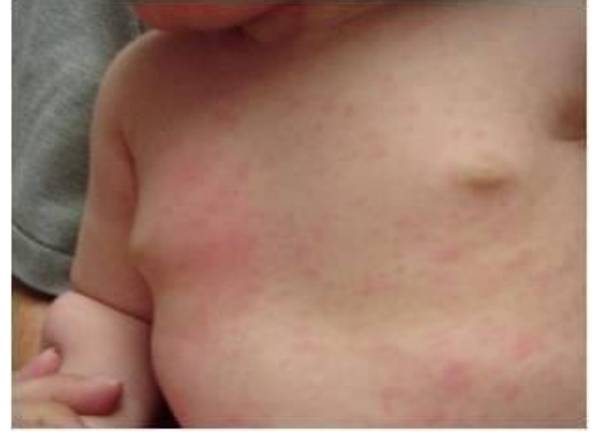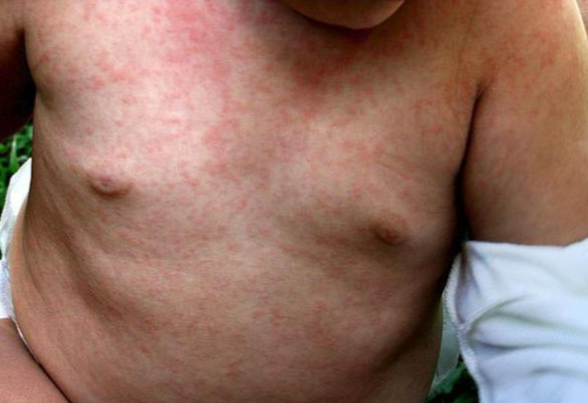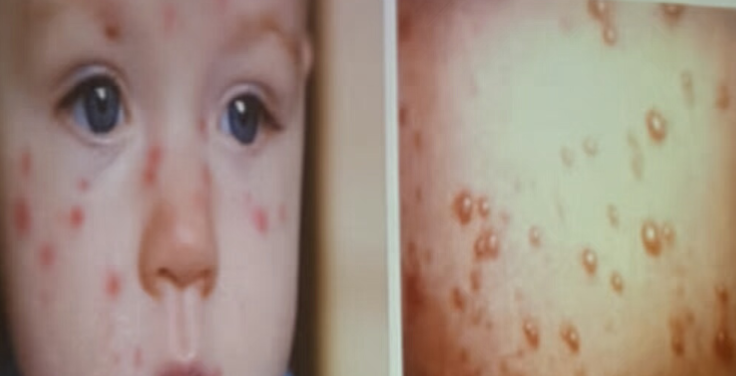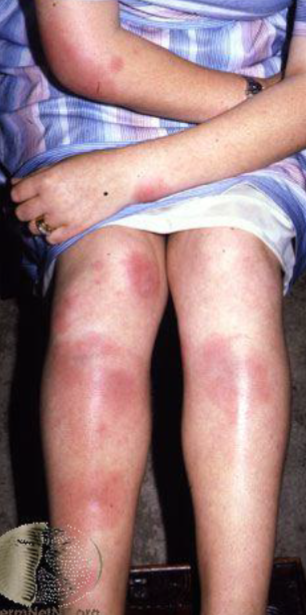Tuberculin Skin Test
- Picture: of tuberculin skin test
- What is the route of injection? Intradermal
- When the test is positive? When there is 5mm induration in endemic area
Case Study: Infant with Fever and Rash

- An infant suffered from high fever (39.4°C) to (40.6°C)] that lasted 2 days After the fever ended, a rosy-pink rash appeared mostly on the trunk (torso), neck, and arms. The rash is not itchy and lasted for 2 days
- (A) rubela
- (B) rubeola
- (C) rosella infantum
- (D) Measles
Case Study: 8-Year-Old Girl with Brown Urine
An 8-year-old girl was brought to the Emergency department by her mother, complaining of brown-colored urine for 4 days. She had a sore throat 2 weeks ago which resolved spontaneously. The mother noticed puffiness (mild swelling) under her eyes in the last 2 days. She also complained of headache and scanty urine for the last 1 day. On physical examination: HR: 110, R: 26, BP: 140/90, Temp: 37.6. Pale child. CVS EXAM: gallop rhythm, no cardiac murmur. Urine Dipstick Analysis: significant proteinuria and Haematuria.
Q1: Relevant Questions for the Mother
- Vomiting?
- Appetite change?
- Is there any confusion or lethargy?
- Is this the first time this has happened?
- Any family history of similar issues?
Q2: Specific Signs to Look For During Examination
- Hypertension
- Rash
- Hepatosplenomegaly
Q3: Important Investigations
- ASO titer
- Complement assay C3 and C4
Q4: Most Likely Diagnosis and Differential Diagnoses
- Most likely diagnosis: Post-streptococcal glomerulonephritis (PSGN)
- Differential diagnoses: SLE (Systemic Lupus Erythematosus) and Bacterial endocarditis
Q5: Important Points in the Management Plan
- Antibiotics (Penicillin)
- Vasodilator (Nifedipine)
- Diuretic (Lasix)
Case Study: 8-Year-Old Girl with Brown Urine - Repeated
A 8 years old girl was brought to the Emergency department by mother complaining of brown colored urine for 4 days. She had sore throat 2 weeks ago which resolved spontaneously. Mother noticed puffiness (mild swelling )under her eyes in last 2 days. She also complained from headache and scanty urine for last 1 day. On physical examination: HR:110, R: 26, BP: 140/90, Temp: 37.6. Pale child. CVS EXAM: gallop rhythm, no cardiac murmur. Urine Dipstick Analysis: significant proteinuria and Haematuria.
- Write 2 relevant questions, to ask the mother?
- Mention 2 important specific signs you should look for during examination of this child?
- Mention 2 important investigations?
- What is the most likely diagnosis, and give 2 differential diagnoses?
- Mention 2 important points in the management plan?
Answers:
- Q1) Vomiting and appetite change, Is there any confusion or lethargy?, Is this the first time this has happened?
- Q2) Hypertension, Rash, Hepatosplenomegaly
- Q3) ASO titer, Complement assay C3 and C4
- Q4) Post-streptococcal glomerulonephritis (PSGN), SLE and Bacterial endocarditis
- Q5) Antibiotics (Penicillin), Vasodilator (Nifedipine) and Diuretic (Lasix)
 Parent brought their child at the hospital for evaluation due to acute
development of high fever, malaise, and lethargy. On the examination,
the patient is mottled with poor perfusion, tachycardia, and has
developed a new rash.
Parent brought their child at the hospital for evaluation due to acute
development of high fever, malaise, and lethargy. On the examination,
the patient is mottled with poor perfusion, tachycardia, and has
developed a new rash.
Diagnosis: meningeococcemia Immediate treatment: Start IV fluid and antibiotics
 Diagnosis? Scarlet fever
2 clinical features ? Strawberry tongue - sore throat- maculopapular rash (sandpaper)
2 Complications? Pneumonia - Rheumatic fever-glomerulonephritis
Diagnosis? Scarlet fever
2 clinical features ? Strawberry tongue - sore throat- maculopapular rash (sandpaper)
2 Complications? Pneumonia - Rheumatic fever-glomerulonephritis


Q4A-B Q3-A: Most likely the diagnosis? A: Measles. Q3-B: Mention 2 complications? A:
- Viral pneumonia.
- Otitis media.
- Acute encephalitis.
- Diarrhea.
- Secondary Bacterial pneumonia.
Z
 Child with fever and skin rash
Child with fever and skin rash
- what is the diagnosis ? Measles.
- Complication? Pneumonia, Otitis media, Encephalitis.
- Mouth finding? Koplik spot mouth
 Runny nose and 2-3 days erythema with fever
What is the name of disease? Fifth disease (erythema infectiosum)
And causative organism? Parvovirus B19
Runny nose and 2-3 days erythema with fever
What is the name of disease? Fifth disease (erythema infectiosum)
And causative organism? Parvovirus B19

- Diagnosis: Henoch Schonlein purpura


- Parents bring their child in for evaluation due to acute development of high fever, malaise, and lethargy. On exam, the patient is mottled with poor perfusion, tachycardic, and has developed a new rash.
- Description: purpura, petechiae, ecchymosis (non-blanching)
- Diagnosis: Meningococcemia
- Causative agent?
- “Gram -ve Cocci”
- Neisseria meningitidis
- Next step of management?
- Start IV antibiotics
 Vitiligo - Neurocutaneous disease CC
Vitiligo - Neurocutaneous disease CC

- A 9-month-old infant presents with numerous excoriated, erythematous papules and pustules on the wrists, abdomen, periaxillary skin, ankles, and feet. Some of the lesions appear to be infected secondarily. The patient appears uncomfortable. Mother reports that her other children only have a few pruritic lesions. Mother denies any lesions but habitually rubs the interdigital webs of her hand.
- Diagnosis: Scabies
 Congenital Cytomegalovirus:
Congenital Cytomegalovirus:
- A newborn, small for gestational age infant, is noted to have microcephaly, jaundice, hearing loss, and a non-blanching rash on exam. Mother had no known infection during pregnancy and is Rubella immune.
- Diagnosis: Congenital Cytomegalovirus Syndrome

Erythema Marginatum:
- 7-year-old boy complains of severe pain in his left elbow for 2 hours, associated with fever. He also complained of pain in his right knee before 2 days, which lasted for 1 day only. He had a sore throat before 2 weeks.
- Q2. What is the most likely diagnosis of the child’s disease?
- a. Ringworm.
- b. Erythema annulare centrifugum
- c. Erythema marginatum
- d. Annular urticaria
Acute Rheumatic Fever:
- Q2. What is the most likely diagnosis of the child’s disease?
- a. Acute rheumatic fever
- b. Still’s disease
- c. Kawasaki syndrome

 One-year-old boy presented to ER with this rash. He had a febrile illness for the last 3 days and had one episode of seizure. His fever had subsided, but the rash appeared thereafter.
Findings: Roseola Infantum:
One-year-old boy presented to ER with this rash. He had a febrile illness for the last 3 days and had one episode of seizure. His fever had subsided, but the rash appeared thereafter.
Findings: Roseola Infantum:
- Q2. What is the likely cause of the illness?
- a. Human herpesvirus 6 (HHV-6)
- b. Epstein-Barr virus (EBV)
- c. Rubella virus.
- d. Measles Virus.
- Cause of seizure? Febrile seizures
Case Study: Cervical Lymphadenopathy

Questions
- A-what is the system involved?
- RES (reticuloendothelial system)
- B-give one important symptom in the history of presenting illness?
- Fever, weight loss, night sweats…
- C- the most likely diagnosis?
- Lymphoma
- D- give one extra deferential diagnosis?
- Tb
 What are the observed skin lesions? Vesicles, macules, pustules, and crusted areas.
What are the observed skin lesions? Vesicles, macules, pustules, and crusted areas.
What are the possible diagnoses? Herpes Simplex or Impetigo.

Generalized Maculopapular Rash
What are the possible diagnoses? Measles, Steven-Johnson Syndrome (SJS), or drug allergies.

Chickenpox
What are the observed skin lesions? Vesicles. What is the likely diagnosis? Chickenpox.

An 8-year-old boy with rectal temperature of 38°C
- Bilateral tender parotid swelling, and pain when you flex his neck. He has been complaining of a headache. His immunization history is unknown.
- What is the most likely cause of this child’s infection? Mumps
- Virus? Paramyxovirus
- Complication? Orchitis, Meningitis, Parotiditis
Gram Positive Diplococcus
- What? Gram-positive diplococcus.




Case
You examine an 13-year-old male with a 5-day history of fever, sore throat, and fatigue. Physical examination reveals an exudative tonsillitis and bilateral enlarged and slightly tender posterior cervical lymph nodes. The spleen is palpable 3 cm below the rib cage. Which agent is most likely responsible for this patient’s illness? Adenovirus

Case
A previously well 12-year-old girl presents to clinic because of painful swellings on the front of the legs of about 3 days’ duration. Examination reveals tender erythematous nodules, 1–2 cm in diameter, on the extensor surfaces of the lower legs. The remainder of the physical examination is unremarkable. Which of the following is most likely to confirm the cause of this condition? Throat swab
Tuberculin Skin Test:
- What is the route of injection? Intradermal
- When is the test positive? When there is 5mm induration in an endemic area